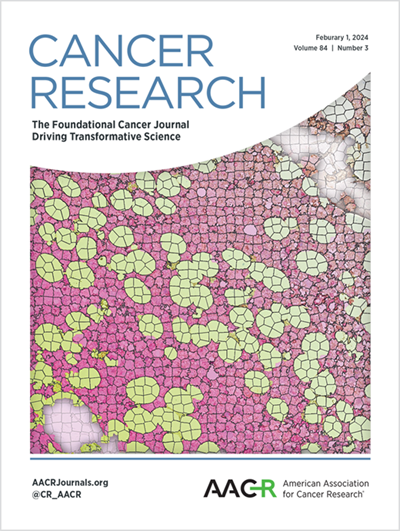MTHFD2 Enhances cMYC O-GlcNAcylation to Promote Sunitinib Resistance in Renal Cell Carcinoma
IF 12.5
1区 医学
Q1 ONCOLOGY
引用次数: 0
Abstract
Sunitinib is a first-line targeted therapy for patients with renal cell carcinoma (RCC), but resistance represents a significant obstacle to the treatment of advanced and metastatic RCC. Metabolic reprogramming is a characteristic of RCC, and changes in metabolic processes might contribute to resistance to sunitinib. Here, we identified MTHFD2, a mitochondrial enzyme involved in one-carbon metabolism, as a critical mediator of sunitinib resistance in RCC. MTHFD2 was elevated in sunitinib resistant RCC cells, and loss of MTHDF2 conferred sensitivity to sunitinib. In patients, MTHFD2 was highly expressed in RCC and was associated with poor outcomes. Mechanistically, MTHFD2 stimulated UDP-GlcNAc biosynthesis and promoted cMYC O-GlcNAcylation by driving the folate cycle. O-GlcNAcylation enhanced cMYC stability and promoted MTHFD2 and CCND1 transcription. Targeting MTHFD2 or cyclin D1 sensitized tumor cells to sunitinib in vitro and in vivo. Consistently, development of a peptide drug capable of efficiently degrading MTHFD2 enabled reversal of sunitinib resistance in RCC. These findings identify a noncanonical metabolic function of MTHFD2 in cell signaling and response to therapy and reveal the interplay between one-carbon metabolism and sunitinib resistance in RCC. Targeting MTHFD2 could be an effective approach to overcome sunitinib resistance.MTHFD2增强cMYC o - glcn酰化促进肾细胞癌舒尼替尼耐药
舒尼替尼是肾细胞癌(RCC)患者的一线靶向治疗,但耐药性是晚期和转移性肾细胞癌治疗的一个重大障碍。代谢重编程是RCC的一个特征,代谢过程的改变可能有助于对舒尼替尼的耐药性。在这里,我们发现MTHFD2,一种参与单碳代谢的线粒体酶,是RCC中舒尼替尼耐药的关键介质。MTHFD2在舒尼替尼耐药的RCC细胞中升高,MTHDF2的缺失使其对舒尼替尼敏感。在患者中,MTHFD2在RCC中高表达,并与不良预后相关。从机制上讲,MTHFD2通过驱动叶酸循环刺激UDP-GlcNAc生物合成并促进cMYC o - glcnac酰化。o - glcn酰化增强了cMYC的稳定性,促进了MTHFD2和CCND1的转录。靶向MTHFD2或cyclin D1使肿瘤细胞对舒尼替尼体外和体内增敏。与此同时,一种能够有效降解MTHFD2的肽药物的开发使RCC中的舒尼替尼耐药性得以逆转。这些发现确定了MTHFD2在细胞信号传导和治疗反应中的非规范代谢功能,并揭示了RCC中一碳代谢与舒尼替尼耐药之间的相互作用。靶向MTHFD2可能是克服舒尼替尼耐药的有效途径。
本文章由计算机程序翻译,如有差异,请以英文原文为准。
求助全文
约1分钟内获得全文
求助全文
来源期刊

Cancer research
医学-肿瘤学
CiteScore
16.10
自引率
0.90%
发文量
7677
审稿时长
2.5 months
期刊介绍:
Cancer Research, published by the American Association for Cancer Research (AACR), is a journal that focuses on impactful original studies, reviews, and opinion pieces relevant to the broad cancer research community. Manuscripts that present conceptual or technological advances leading to insights into cancer biology are particularly sought after. The journal also places emphasis on convergence science, which involves bridging multiple distinct areas of cancer research.
With primary subsections including Cancer Biology, Cancer Immunology, Cancer Metabolism and Molecular Mechanisms, Translational Cancer Biology, Cancer Landscapes, and Convergence Science, Cancer Research has a comprehensive scope. It is published twice a month and has one volume per year, with a print ISSN of 0008-5472 and an online ISSN of 1538-7445.
Cancer Research is abstracted and/or indexed in various databases and platforms, including BIOSIS Previews (R) Database, MEDLINE, Current Contents/Life Sciences, Current Contents/Clinical Medicine, Science Citation Index, Scopus, and Web of Science.
文献相关原料
公司名称
产品信息
索莱宝
Formate
 求助内容:
求助内容: 应助结果提醒方式:
应助结果提醒方式:


